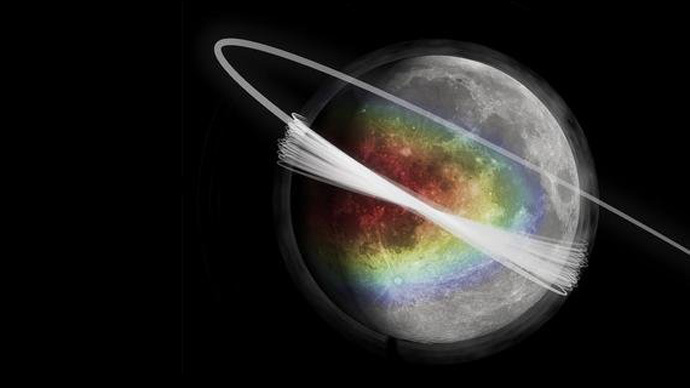Scientists discover ‘permanent’ dust cloud around Moon

There is a permanent, but asymmetric dust cloud surrounding the Moon, created by tiny dust grains lifted up from the lunar surface, scientists have found. Its density may increase during annual meteor showers such as, for example, Geminid.
According to scientists from, the cloud is comprised of dust grains swept up by other high-speed, interplanetary particles passing by, often in the wake of comets.
Many of the dust particles are traveling at thousands of miles per hour in the opposite orbital direction of the solar system’s planets, causing high-speed, near head-on collisions with the moon’s leading surface, said Professor Mihali Horanyi.
According to Horanyi, even a single dust particle from a comet striking the moon can excite thousands of smaller particles on the surface. An event of this sort makes the dust hang in the airless environment for days.
The lunar cloud was detected using NASA data from the Lunar Atmosphere and Dust Environment Explorer (LADEE), which was sent up in 2013 to orbit the moon for six months. An onboard detector, built in Boulder Colorodo, recorded over 140,000 impacts with the Moon’s surface in that period.
Scientists have noticed that this rustling up of particles comes every December with the arrival of the Geminid shower, just as Earth passes through a cloud of space debris.
This is when the dust cloud around the moon is especially thick.
“When these ‘beams’ we see from meteors at night hit the moon at the right time and place, we see the cloud density above the Moon skyrocket for a few days,” said Horanyi.
READ MORE: Cosmic chaos: Pluto's moons drunkenly dance around dwarf planet, study says
The discovery of this permanent cloud, according to Horanyi, “is a nice gift from the mission.”
“We can carry these findings over to studies of other airless planetary objects like the moons of other planets and asteroids,” Horanyi said.
The findings appear in a study in the June 17 issue of the journal Nature.
For Horanyi, the discovery has practical implications. Dust travels at ultra-high speeds and has been known to damage spacecraft and space suits. Being able to predict its course and timing can better prepare humanity for future space missions.
The lunar dust cloud was first theorized in the 1960s, with the aid of unmanned moon landers. Several years later, an Apollo mission orbiting the rock saw a distinct glowing disk too bright to have been illuminated by the Sun. The glow was determined to have come from the Moon itself.
As the latest findings from LADEE did not match the Apollo astronauts’ reports of a thicker, higher dust cloud, Horanyi assumes that conditions may have been different back then. Horanyi will be keeping a close eye on the New Horizons mission that is scheduled to reach Pluto by July 14. He is the principle research scientist for the dust-counting instrument on that space craft.












